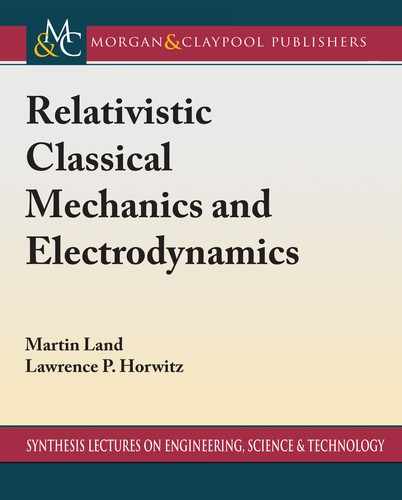
20 2. CANONICAL RELATIVISTIC MECHANICS
2.4 TWO-BODY PROBLEM WITH SCALAR POTENTIAL
As we showed in Section 1.4, the two-body problem with scalar interaction can be written as
an equivalent one-body problem
K D
p
2
1
2M
1
C
p
2
2
2M
2
C V
.
x
1
x
2
/
D
P
P
2M
C
p
p
2m
C V .x/; (2.4)
where the center of mass motion satisfies
P
P
D 0. Arshansky [1] studied classical problems of
this type (for the extension to quantum mechanics, see [2]), generalizing the standard nonrela-
tivistic central force problems by taking
V .x/ D V
p
x
2
! V.x/ D V
p
x
2
c
2
t
2
for spacelike separations, x
2
> 0. Restriction to the spacelike region can be accomplished
through a representation in hyperspherical coordinates of the type
x D
sinh ˇ
cosh ˇ Or
Or D
2
4
sin cos
sin sin
cos
3
5
Or
2
D 1:
But it was found that reasonable solutions lie in a subspace of the full spacelike region, found by
choosing a spacelike unit vector n
and solving the equations of motion in the O(2,1)-invariant
restricted space
x 2
˚
x j Œx .x n/n
2
0
for which the component of x orthogonal to n is itself spacelike. Arshansky has described this as
a classical case of spontaneous symmetry breaking leading to a lowering of the energy spectrum.
Taking n D .0; 0; 0; 1/ this region has the representation
x D
sin Oq
cos
Oq D
2
4
sinh ˇ
cosh ˇ cos
cosh ˇ sin
3
5
Oq
2
D 1: (2.5)
In addition to the O(3,1) invariant l
2
defined in (2.3), the O(2,1) invariant
N
2
D L
2
3
A
2
1
A
2
2
with components defined in (2.2) is also conserved and plays a role in characterizing the solu-
tions. In these coordinates, the first integrals
K D
p
2
2M
C V .x/ D
1
2
M P
2
C
l
2
2M
2
C V ./ D
..................Content has been hidden....................
You can't read the all page of ebook, please click here login for view all page.
